The history of the Cairo Opera goes back to the second half of the 19thcentury when the gem of architecture known as the Khedivial Opera House was inaugurated in the heart of Cairo.
Unfortunately in 1971 the opera burned down and it took 17 years for Cairo to have its new opera house. The new opera house was inaugurated on 10 October 1988.
While on 10 and 11 October, the Cairo Opera House celebrates its 31stanniversary, it is worth looking into some details of the three decades, a history which witnessed numerous developments of the opera as well as the many troupes that operate under its wings.
1869: Egypt's first Opera House officially opened during the reign of Khedive Ismail.
Designed by Italian architect Pietro Avoscani, the Khedivial Opera House was opened on the occasion of the inauguration of the Suez Canal.
The old opera house was located in the Azbakiya district in central Cairo.
28 October 1971: A fire tragically burned down the opera building completely.
1971 – 1988: Troupes which were housed by the Khedivial Opera House were relocated to the Gomhoriya Theatre situated near Abdeen Royal Palace. However their continuity was challenged by the lack of proper home.
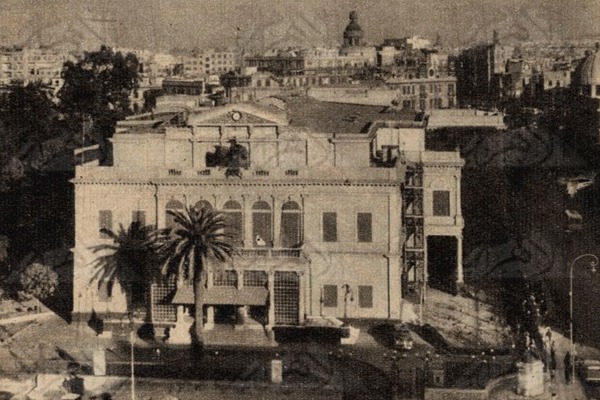
The old Opera House in Azbakiya (Photo: Al Ahram archives)
1985: Egypt initiated a cooperation with Japan's International Cooperation Agency (JICA) to build a newNational Cultural Centre which aimed, among many other activities, at serving as a theatre for operatic and symphonic performances. The centre was soon called the New Opera House.
1987-1988: Egypt’s well-known ballerina, Magda Saleh, served as the first chairperson of the new opera house during its construction phase.
10 October 1988: The new opera house was inaugurated in 1988 by then-president Hosni Mubarak and Japan's Prince Tomohito of Mikasa, the younger brother of the Japanese Emperor.
The Opera House's main hall is designed to seat 1300 spectators, lends its stage to symphonic concerts and performances; the small hall (350 seats) and open air theatre present recitals, light music concerts, cinema clubs, artistic salons and special performances.
The troupes which found their home at the new opera were: the Heritage Ensemble for Arab Music (whose history goes back to 1932), the Cairo Opera Company (established in 1952), the Cairo Opera Choir (established in 1956), the Cairo Symphony Orchestra (established in 1959), and the Abdel-Halim Noweira Ensemble for Arab Music (established in 1967).
Back then, the Cairo Ballet Company was an adjunct to the Academy of Arts.
1988-1990: Renowned opera singer Ratiba El-Hefny assumed the position of the chairperson overlooking the opera’s opening and start up of actual activities.
1989: Newly formed troupes were added to the opera’s artistic family: the National Arab Music Ensemble and the Cairo Opera House Children’s Choir with Selim Sehab as conductor and artistic director.
1990-1991: Musician Tarek Ali Hassan took over the chair of the opera.
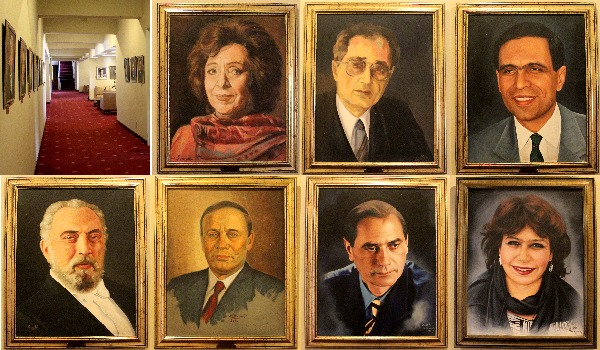
Paintings of the new Cairo Opera House consecutive directors decorate a corridor inside the building. Paintings from top left: late Ratiba El-Hefny (1988-1990), Tarek Ali Hassan (1990-1991), late Nasser El-Ansary (1991-1997), Moustafa Nagui (1997-2000), Samir Farag (2000-2004), late Abdel-Moneim Kamel (2004-2012), Ines Abdel-Dayem (2012-2018). The photos do not include Magda Saleh (1987-1988) and current chairperson Magdy Saber (2018-)
Early 1990s: The Cairo Ballet Company finally abandoned its previous status since 1966 as an adjunct to the Academy of Arts and was adopted by the Opera House, becoming the Cairo Opera Ballet Company.
1991: The famed Maurice Béjart (1927 – 2007) and his troupe performed a ballet titled Pyramide – El-Nour paying tribute to Egyptian history.
Tarek Ali Hassan also expanded the music library which by this time suffocated in a small room inside the building. Ali Hassan thus decided to add a new building to the opera grounds which would hold the musical scores, recordings and books. The project was resumed and finalised in 1994 by the subsequent director of the Opera House.
1991-1997: Nasser El-Ansary became chairperson director of the Opera House.
Internationally-celebrated names started being frequent visitor of the opera's stages: Ballet of Opera Varna and the Sofia International Opera (Bulgaria), the New Classical Ballet (Moscow), the Dance Theatre of Harlem, the Renato Greco Contemporary Dance Company (Italy) and the Stockholm Youth Symphony Orchestra (Sweden) were among the first to visit the new opera's stage and perform to Egyptian audiences.
1992: The Cairo Opera Dance Theatre Company was launched, performing contemporary dance with Walid Aouni as choreographer and artistic director.
1994: The Cairo Opera Orchestra was founded, becoming the second national orchestra under the Cairo Opera's umbrella.
It is important to note that until that moment, the Cairo Symphony Orchestra had been performing a repertoire of symphonic, operatic and ballet shows. The establishment of the Cairo Opera Orchestra allowed it to assume the responsibility of the music for the operas and ballets, leaving the symphonic repertoire to the Cairo Symphony Orchestra.
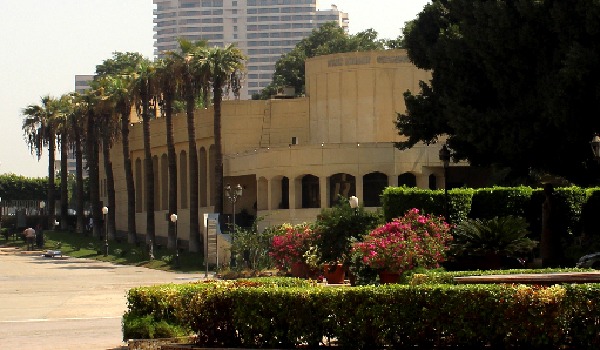
The Music Library at the Cairo Opera House grounds (Photo: Ati Metwaly)
1994: The Opera House brought to life the first mega production of opera Aida in Luxor, marking one of Nasser El-Ansary's most significant initiatives.
October 1997: The memorable Aida performance was staged against the backdrop of the Deir Al-Bahari Temple. A terrorist attack on tourists a month later, however, brought an end to opera performances in Luxor.
1997-2000: Moustafa Nagui, the new chairperson of the Cairo Opera moved Aida to the Pyramids in 1998, with alternations between the Giza plateau and the Cairo Opera House following the move.
2000-2004: General Samir Farag became the opera’s chairperson.
Some activities began to vanish from the opera’s schedule. The Cairo Symphony Orchestra no longer gave concerts at universities; the number of concerts tailored for young audiences severely diminished, while the television no longer broadcasted the many concerts and performances of Egyptian companies, limiting its coverage of the opera to sporadic highlights of select international troupes.
2004 – 2012: Renowned ballet dancer Abdel-Moneim Kamel became the opera’s chairman.
The opera’s budget allowed many international troupes to perform at the opera, while Kamel's large network of contacts in the field facilitated the exchange.
During his term, audiences could attend evenings with Seven Pianos, Zurich Ballet and Winterthur Orchestra (Switzerland), Istanbul State Symphony Orchestra (Turkey), National Academic Bolshoi Ballet (Belarus), Teatro Greco Dance (Italy) and many more.
Despite the countless flashy names that crossed the opera stage at the time, alleged administrative gaps were posing a challenge to the opera's link with the different social strata.
The 2011 Revolution changed the face of the Cairo Opera House.
Abdel-Moneim Kamel's annually-renewed contract ended in February 2012, when he was replaced by Ines Abdel-Dayem.
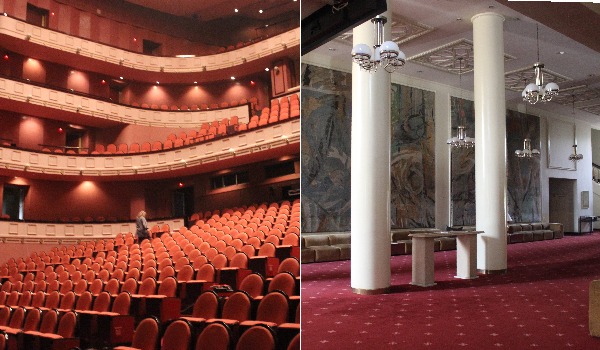
Cairo Opera House main hall (left) and lobby (Photo: Ati Metwaly)
2012-2018: Ines Abdel Dayem served as the opera’s chairperson.
However her chairmanship was interrupted by her dismissal (May-July 2013) at the hands of former minister of culture Alaa Abdel-Aziz, appointed by then president Mohamed Morsi.
May-June 2013: Badr El-Zakaziky served as opera director under complicated circumstances: not only was June heralding the end of the opera season but also, and more importantly, those days were marked by a series of artists' protests and sit-ins against Abdel-Dayem's dismissal.
Abdel-Dayem was reinstated in July by the new minister of culture, Mohamed Saber Arab.
Post-revolution years were characterized by many changes within the Cairo Opera House. Among many issues, the smaller budget placed on numerous sectors of the opera no longer allows for the internationally renowned troupes to visit Egypt.
The Cairo Opera began depending on local artists in most of the performances, something that particularly affected the Cairo Opera Ballet Company which saw departure of several foreign dancers.
Despite the challenges and in many cases depending on its own resources, the troupes managed to give premieres to numerous operatic and ballet performances.
Opera also opened the doors to many independent bands and initiated operations with the Cairo-based international cultural centres and embassies hosting their guests on the opera’s stages. Though this strategy opened doors to many new artists, it also meets criticism related to the quality of the performances and concerts staged at the opera’s halls.
2018: Ines Abdel-Dayem was appointed the new minister of culture and the chairmanship of the opera is given to former ballet dancer Magdy Saberwho in many aspects continues to implement strategies set by Ines Abdel Dayem.
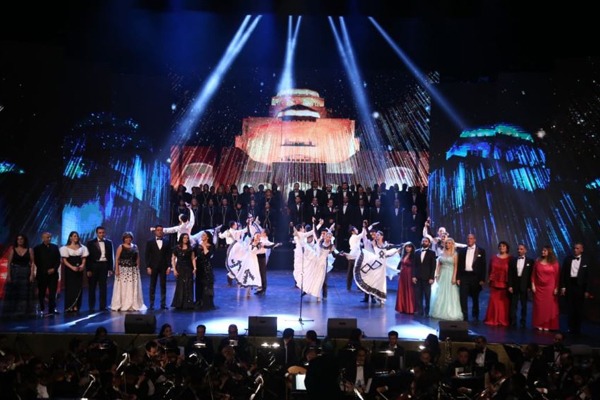
Celebrations of the Cairo Opera House's 31st anniversary on 10 October 2019. (Photo: courtesy of the Cairo Opera House)
For more arts and culture news and updates, follow Ahram Online Arts and Culture on Twitter at @AhramOnlineArts and on Facebook at Ahram Online: Arts & Culture
Short link: